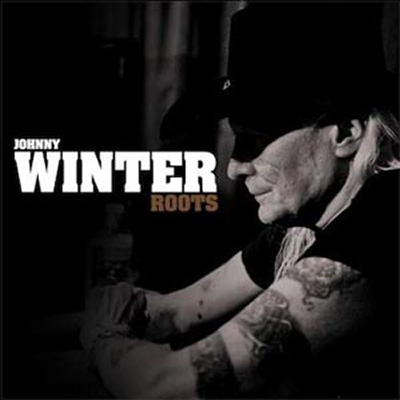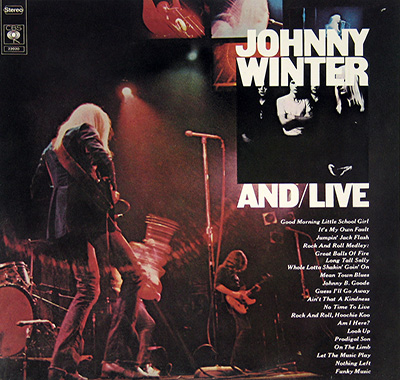The cities of Beaumont, Port Arthur, and Orange in southeast Texas form an area called the Golden Triangle. It is a region known for oil and sulfur production, shipbuilding, rice farming, and shrimping. Lying near the Gulf Coast and very close to Louisiana, the Triangle is home to a variety of cultural and ethnic influences: French and European, Native American, African, Caribbean, and Mexican. Here, rock'n'roll, blues, western swing, gospel, and R&B ingredients mix with Cajun and Creole flavors to yield a rich, complex, and hearty musical gumbo. The sounds emanating from the regional radio stations in the 1950s and early 1960s were no less diverse. This was the land of T-Bone Walker, Blind Lemon Jefferson, and Lightnin' Hopkins; of Buddy Holly and Bob Wills; of Clifton Chenier and Gatemouth Brown. These musicians made an indelible impression on a young and receptive Johnny Winter. Inundated and inspired by the multifarious sonic currents, he embarked on an irrevocable artistic course while still in his preteen years, assembling his musical lexicon from radio and records, and building the foundation of his striking instrumental and vocal style with a no-compromise philosophy of approaching the blues.
Born in Leland, Mississippi, and raised in Beaumont, Johnny took up the clarinet at age four. The young musician was unable to continue on the instrument due to his overbite and switched to the ukulele and, finally, to guitar when he was around 11. Encouraged by their father, who played sax and banjo, sang in the church choir, and was an ardent fan of big-band jazz, Johnny and his younger brother Edgar participated in family songfests that included involved barbershop quartet harmonies, accompanied by their mother on piano. These early experiences sharpened the Winter ears and vocal cords, providing a natural and supportive environment of invaluable musical training.
Concurrent with his switch to the guitar was Johnny's discovery of the blues. Already enamored of rock'n'roll, he was drawn to Clarence Garlow's radio show and the intriguing sounds of artists such as Howlin' Wolf, Bobby "Blue" Bland, Otis Rush, and Muddy Waters. Garlow, a recording artist in his own right, became something of a mentor to Johnny, sharing obscure blues records with him and teaching him the basics of playing and important details like using an unwound third string to facilitate bending notes. Additionally, Winter sought out local guitarists Luther Naley (who played with cowboy star Roy Rogers) and Seymore Drugan to show him some country and jazz licks and chords. Most of his practical musical education, however, came from "learning to play a record note by note."
At around age 14, Johnny began playing professionally. By then, he had accumulated an enormous record collection and had, in fact, learned to play much of it note-for-note; his tastes ranged from rock'n'roll (Elvis, Carl Perkins, Fats Domino) to R&B (Little Richard, Chuck Berry) and post-war Chicago blues (Muddy Waters, Otis Rush). After a series of abortive groups with Edgar (It and Them, Johnny and the Jammers, the Black Plague), Johnny traveled and worked as a backup guitarist for regional touring bluesmen. During this period, he recorded some demo tracks that have since appeared on numerous unauthorized collections, including First Winter, About Blues, and Early Times.
Eventually, Johnny cut a proper demo album for the
Sonobeat label
. While he was busy shopping this record (which was ultimately released by Imperial Records as
The Progressive Blues Experiment
) to the bigger companies, Rolling Stone magazine printed a glowing article on the ambitious Texas blues scene and the sensational unsigned local guitarist. In their 1968 feature, writer Larry Sepulvado described Winter vividly as "a 130-pound, cross-eyed albino with long, fleecy hair, playing some of the gutsiest, fluid blues guitar you've ever heard." This review set in motion a chain reaction that catapulted Johnny to the forefront of the era's blues and rock movement.
Steve Paul
was a self-styled entrepreneur in New York City. He owned and ran The Scene, a celebrated East Coast nightclub, managed Tiny Tim, and (among other ventures) had an ear for finding talent. Paul tracked down Johnny in Houston, signed him to a management contract, and quickly packed him off to New York to appear at The Scene. By the end of the year, Johnny Winter was the talk of the town, playing to capacity audiences and frequently jamming with the likes of Jimi Hendrix and Jeff Beck. Of the former, Johnny recalls, "The trouble when we played together was that we both respected each other's playing so much that we'd lay back and wait for the other to play lead. We both learned from the same people, had the same influences, but the music evolved differently. He really loved the way I played, especially my slide playing. He said I should stick with the blues and not feel weird because I was white. He told me, 'You got it. You don't have to change anything; just keep doing what you're doing.'"
Johnny kept doing what he was doing on his first official release in 1969,
Johnny Winter.
Signed to Columbia Records with a reputedly massive advance, he produced a work of great lasting value in the genre, a bona fide classic blues-rock album flaunting his talents as guitarist, singer, and composer. Tracks like "Be Careful with a Fool," "I'm Yours and I'm Hers," "I'll Drown in My Tears," and "When You Got a Good Friend" immediately upped the ante for future artists in the form. Showcasing his legendary abilities on both standard and slide guitar, Johnny established his double-pronged attack in short order during the first measures of the opening track, "I'm Yours and I'm Hers," which became a Winter signature song. In the intro (see Example 1), he presents a capsule view of his two different strengths with two contrasting approaches in the same riff. Gtr. I is a standard electric guitar, and Gtr. II is an electric slide guitar in open A tuning (allegedly played on a low-budget Fender Mustang and a converted Fender 12-string, his only guitars for the session). The riff, rhythmically active yet harmonically vague in the best blues sense, combines minor and dominant 7th sounds (A pentatonic minor and A Mixolydian) in bars 2 and 4 and a variety of textures: chords, single-note lines, dyads, and vocalesque slide licks. For slide guitar, Johnny employs open tunings as had countless bluesmen before him. He gravitates to four specific tunings: E, G, and D, for the most part, favoring open A and E. In utilizing open tunings, the idea is to retune the guitar so that it sounds like an open chord. Each has its own distinct sound, purpose, and tradition. Open A (low to high: E A E A C# E) is derived from the parent chord A/E and involves raising the fourth, third, and second strings up one full step (whole step). This tuning is ubiquitous, heard in the work of 1930s Delta blues legend Robert Johnson ("Cross Road Blues," "Traveling Riverside Blues") and contemporary blues/pop performer Bonnie Raitt, among others. Open E (E B E G# B E) originates from a stock E chord and is created by raising the fifth and fourth strings a full step and the third string a half step. This one is a favorite of many Chicago musicians, including Muddy Waters, Hound Dog Taylor, and Earl Hooker. Open G (D G D G B D) is said to have a country-blues quality and, appropriately, is found in the repertoires of older guitarists like Charley Patton, Son House, and Fred McDowell, though modern players such as Keith Richards have not resisted its lure. It is formed by lowering notes on the sixth, fifth, and first strings one full step each to emulate a G/D chord. The fourth, open D (D A D F# A D), is closely associated with Elmore James ("Dust My Broom," "Blues Before Sunrise") and was recently used by Eric Clapton on his From the Cradle album. Additionally, it is helpful to consider the distinction between raised and dropped tunings. Open A and E can be thought of as raised since they are the result of raising the pitch of strings, while open G and D are the reverse or dropped tunings. Each has its own unique feel, atmosphere, and aesthetic effect.
"Be Careful with a Fool," a fiery reinterpretation of the B.B. King slow-blues standard, is a fine example of Johnny's fluid, high-energy solo style. His playing is spellbinding and virtuosic, creating numerous climaxes, filling time and space with cascades of well-placed, multi-note improvisations, and milking the moment with the flair of a master storyteller. Example 2 is the opening guitar statement. Trademark elements include the free-form mixture of C pentatonic minor (C E♭ F G B♭) and C blues (C E♭ F G♭ G B♭) scales, aggressive string bends, and vicious note cramming at 0:08.
Johnny drives home a shared-shape idea behind the second verse (0:57-1:03) of "Be Careful with a Fool" (Ex. 3 and 3a). Here, he uses a single diminished triad shape to produce the C7 to F7♯9 chord progression. The shape, common to both chords, is moved a very short distance, just a half step lower, to accomplish the transition. This is one of the idiom's all-time indispensable chord mannerisms and a fixture in both vintage blues and modern blues-rock, having been memorably appropriated by Edward Van Halen in his "Ice Cream Man" guitar solo.
By mid-1969, just a few months after the release of Johnny Winter, many of the most illustrious names in rock, pop, and blues counted themselves among Winter's greatest admirers. Superstars like John Lennon offered him material, while The Rolling Stones paid him an enormous compliment by kicking off their famed Hyde Park comeback concert in July 1969 with their rendition of "I'm Yours and I'm Hers."
With a successful eponymous debut recording, Johnny entered his prime early and maintained an initial thrust through the first four albums on Columbia from 1969 to 1972. These albums comprise what most listeners perceive and regard as the definitive works of his classic period, though Winter’s releases in the late 1970s and 1980s are no less excellent musically.
Second Winter, recorded in Nashville in 1969, features brother Edgar on keyboards and saxophone and was a superb follow-up. This is a wide-ranging collection combining hard-hitting blues-rock numbers such as "Memory Pain," standards like "Johnny B. Goode" and "Slippin' and Slidin'," the Bob Dylan tune "Highway 61 Revisited," and several original compositions. On this recording, Johnny's tone evolved as he opted for a Gibson Les Paul Special guitar and experimented with amp-miking techniques.
"Memory Pain," a standout track, is a prime example. Here, Johnny achieves a heavy, echoing, midrange-boosted sound that borders on hard-rock intensity (reputedly the result of recording the amp in a stairwell). In addition to its powerful tone, "Memory Pain" features a multifaceted and active rhythm guitar approach that effectively splits the difference between blues, rock, and funk styles, seamlessly melding rhythm and lead textures. Example 4 depicts the opening measures, which set the mood of the piece. Notice the pronounced syncopations throughout (particularly the emphasis on the "and" of beat 3), the parallel 4th dyads in bar 1 (staples of hard rock and metal), and the percussive muted-string strums in bars 2 and 3 (well-known funk music clichés) mixed with Johnny’s familiar blues-based lead fills in bar 3. It all adds up to a very colorful rhythm figure, especially effective and propulsive in this power-trio context, reminiscent of some of Jimi Hendrix’s and Robin Trower’s finest moments.
By 1971’s Johnny Winter And, Johnny retired his old rhythm section of Uncle John "Red" Turner (drums) and Tommy Shannon (bass, later an integral member of Stevie Ray Vaughan's Double Trouble) and enlisted the services of The McCoys as a backup group. The McCoys, featuring teen guitar hero Rick Derringer, had previously scored big in the 1960s with their #1 rock hit "Hang on Sloopy." The Winter-Derringer chemistry proved eminently rewarding as the new ensemble produced a landmark album, distinguished by milestone tracks like "Rock and Roll Hoochie Koo" and "Prodigal Son." By this time, Johnny had adopted the Gibson Firebird as his instrument of choice, formally establishing the signature Winter guitar tone and image. The Winter And band toured extensively worldwide and was captured in concert later in 1971 on Johnny Winter And Live. One of the greatest live recordings of guitar tone, the album included spirited onstage renditions of tunes like "Good Morning Little School Girl," "Meantown Blues," and "Johnny B. Goode."
"Johnny B. Goode" was a dynamic reappraisal of Winter's early rock'n'roll roots and a tribute to an early influence, Chuck Berry, viewed from a new blues-rock perspective (see Ex. 5). Hardly a hollow parody, Johnny paraphrases some of Chuck's most identifiable aspects, including the unmistakable opening guitar break and the striding, boogie-woogie-based comping figure (at 0:10), without sacrificing one note of his own guitar persona. He adds some new wrinkles in the form of slurred double stops in bars 3 and 4, slinky string bends in the riff at 0:13, and the singing wide vibrato at 0:16.
In 1972, Johnny's mounting drug and alcohol problems and excessive lifestyle forced him into a lengthy semi-retirement. He reemerged in 1973 with an outstanding album fittingly titled Still Alive and Well. This album contains "Silver Train," a song penned for him by Mick Jagger and Keith Richards, and a sterling version of "Rock Me, Baby." Johnny continued as one of the most important blues-rock performers of the modern age, maintaining recording activity into the decade. John Dawson Winter III (1974), Captured Live (1976), Nothin' but the Blues (1977), and the particularly smoking White, Hot and Blue (1978), featuring noteworthy blues cuts like "Walkin' By Myself" (Jimmy Rogers) and "Divin' Duck" (Sleepy John Estes). He collaborated with his lifelong idol, Muddy Waters, during this period, producing and performing on a number of records from 1977-1980, which rekindled interest in Waters' career and earned the partnership a Grammy. After 1980's Raisin' Cain, Winter took a four-year hiatus from recording, only to return with Guitar Slinger. This release precipitated a powerful series of albums on Alligator Records in the mid-1980s and quickly put him back on the blues-rock map, quelling any doubts about Johnny Winter's status and significance as one of the most important blues-rock performers of the modern age. Wolf Marshall





























